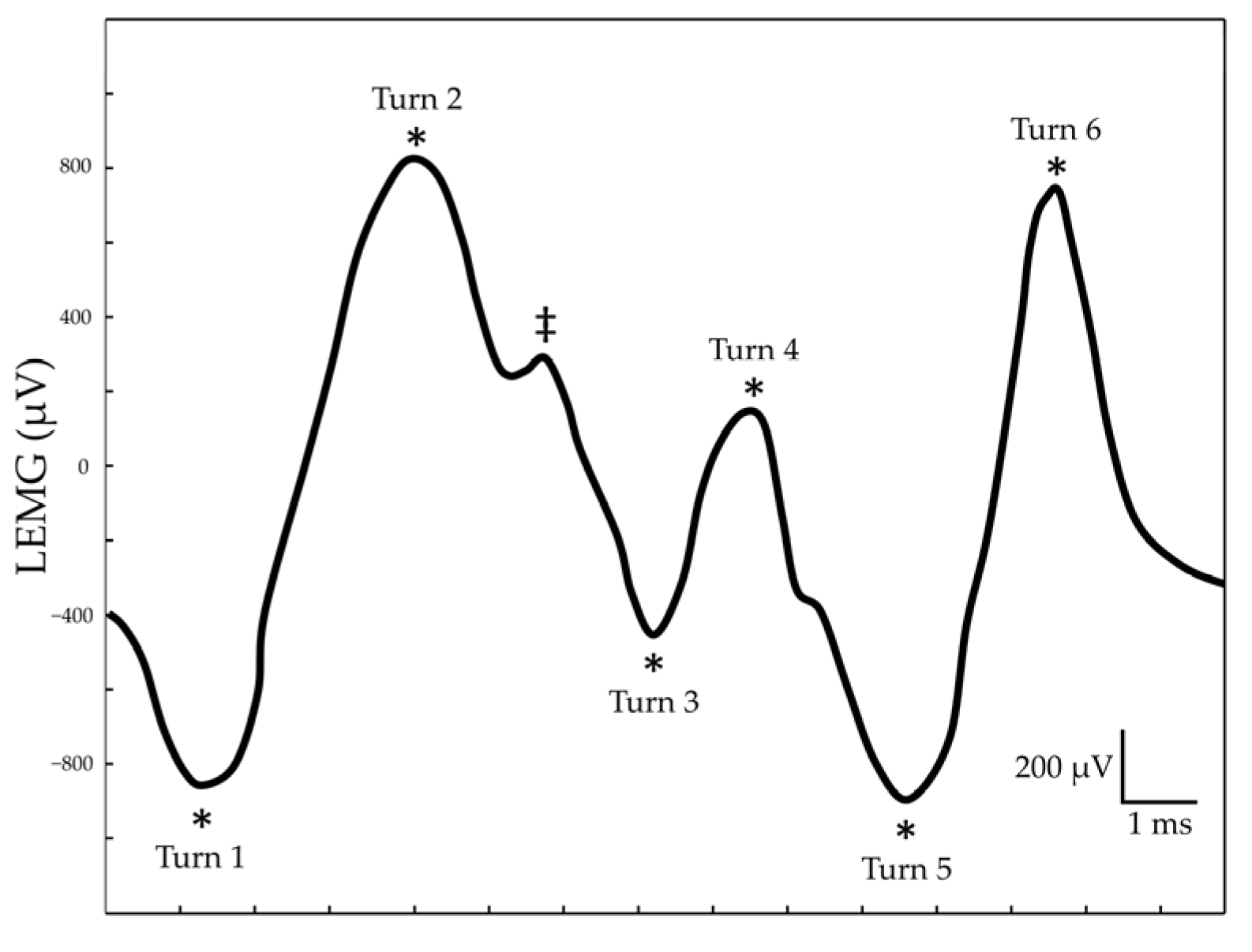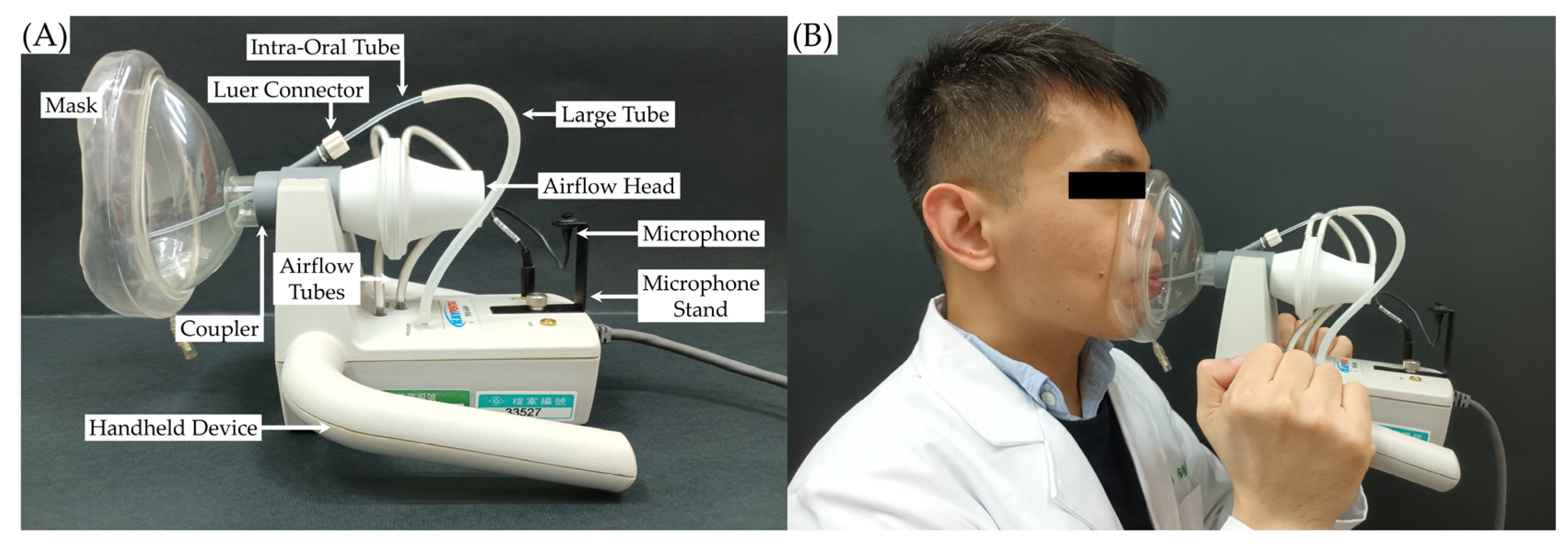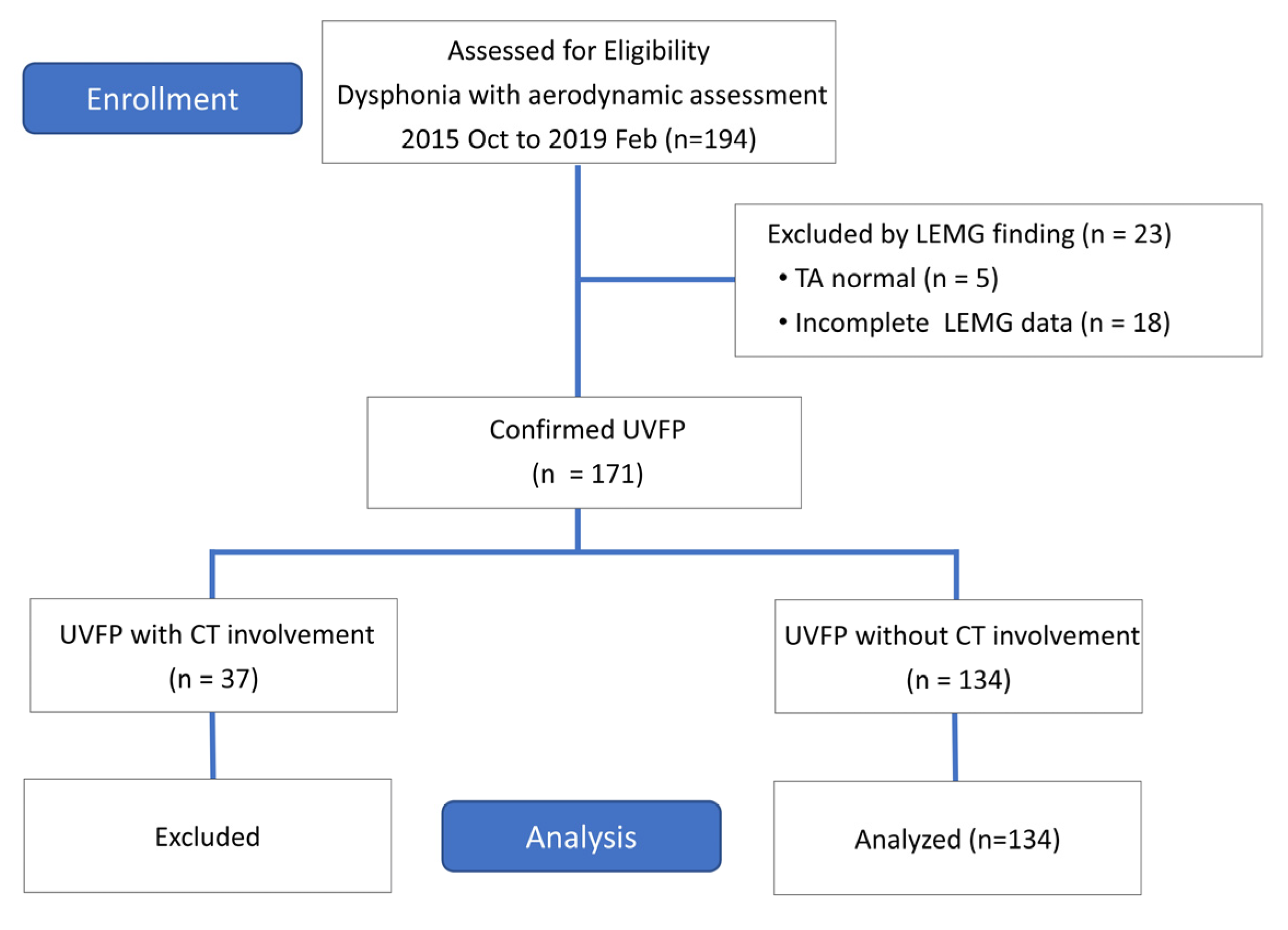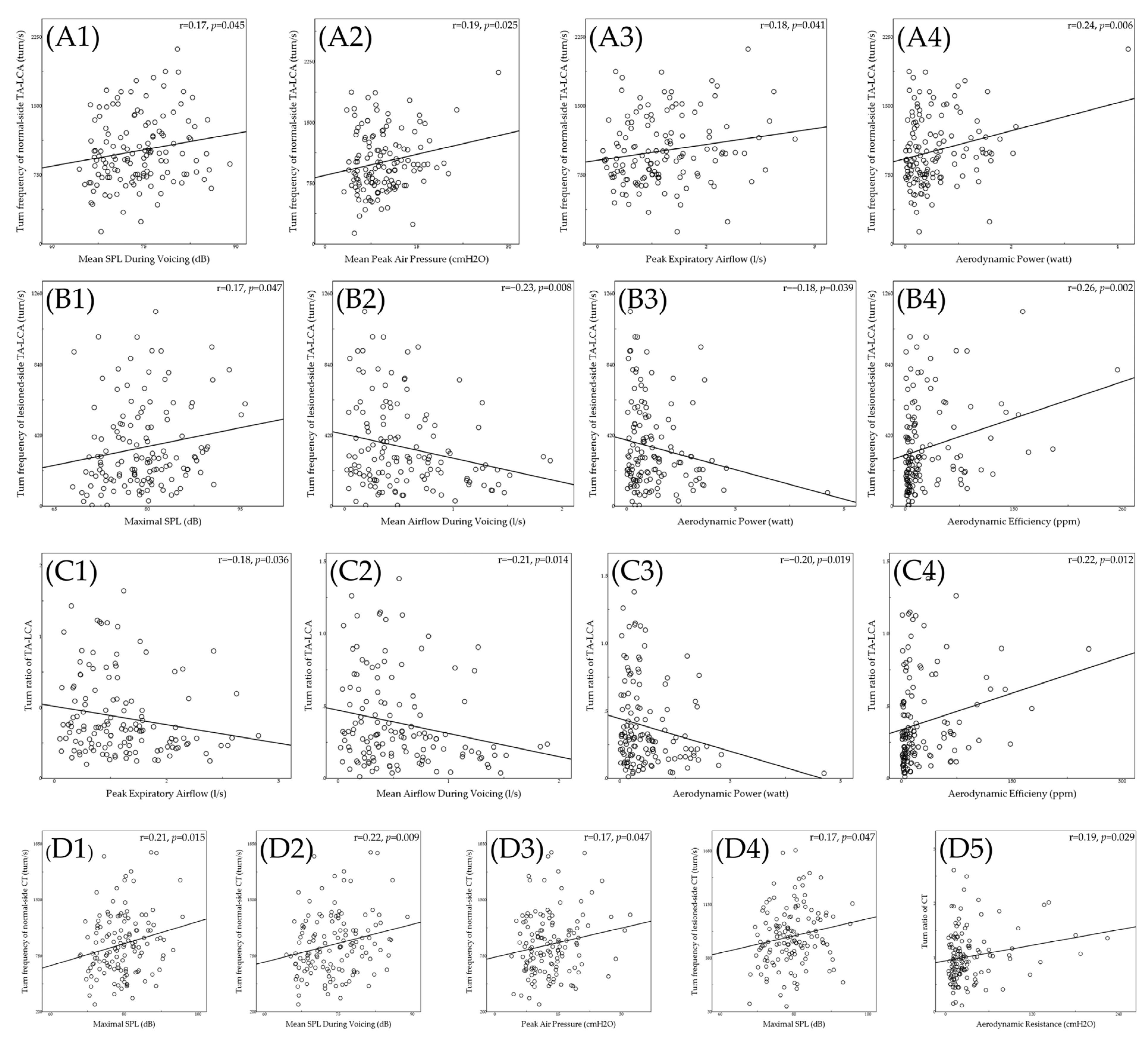Aerodynamic Performance and Neuromuscular Control in Patients with Unilateral Vocal Fold Paralysis
Abstract
:1. Introduction
2. Materials and Methods
2.1. Patients
2.2. Assessments
2.2.1. Laryngeal Electromyography (LEMG)
2.2.2. Quantitative LEMG Analysis
2.2.3. Videolaryngostroboscopy
2.2.4. Aerodynamic Analysis
2.3. Statistical Analysis
3. Results
3.1. Patient Characteristics
3.2. Aerodynamic Analysis
3.3. Quantitative Laryngeal Electromyography Assessment
3.4. Correlations between Quantitative LEMG and Aerodynamic Parameters
3.5. Prognostic Indicators of the Aerodynamic Parameters
4. Discussion
5. Limitation
6. Conclusions
Author Contributions
Funding
Institutional Review Board Statement
Informed Consent Statement
Data Availability Statement
Conflicts of Interest
References
- Koufinan, J.A.; Walker, F.O.; Joharji, G.M. The cricothyroid muscle does not influence vocal fold position in laryngeal paralysis. Laryngoscope 1995, 105, 368–372. [Google Scholar] [CrossRef]
- Neel, H.B.; Harner, S.G.; Benninger, M.S.; Crumley, R.L.; Ford, C.N.; Gould, W.J.; Hanson, D.G.; Ossoff, R.H.; Sataloff, R.T. Evaluation and Treatment of the Unilateral Paralyzed Vocal Fold. Otolaryngol. Neck Surg. 1994, 111, 497–508. [Google Scholar] [CrossRef] [PubMed]
- Hartl, D.M.; Hans, S.; Vaissière, J.; Riquet, M.; Brasnu, D.F. Objective Voice Quality Analysis Before and After Onset of Unilateral Vocal Fold Paralysis. J. Voice 2001, 15, 351–361. [Google Scholar] [CrossRef] [PubMed]
- Munin, M.C.; Rosen, C.A.; Zullo, T. Utility of laryngeal electromyography in predicting recovery after vocal fold paralysis. Comparative Study. Arch. Phys. Med. Rehabil. 2003, 84, 1150–1153. [Google Scholar] [CrossRef] [PubMed]
- Wang, C.-C.; Chang, M.-H.; Wang, C.-P.; Liu, S.-A. Prognostic Indicators of Unilateral Vocal Fold Paralysis. Arch. Otolaryngol.-Head Neck Surg. 2008, 134, 380–388. [Google Scholar] [CrossRef] [Green Version]
- Statham, M.M.; Rosen, C.A.; Nandedkar, S.D.; Munin, M.C. Quantitative laryngeal electromyography: Turns and amplitude analysis. Laryngoscope 2010, 120, 2036–2041. [Google Scholar] [CrossRef]
- Fang, T.-J.; Pei, Y.-C.; Hsin, L.-J.; Lin, W.-N.; Lee, L.-A.; Li, H.-Y.; Wong, A.M.K. Quantitative laryngeal electromyography assessment of cricothyroid function in patients with unilateral vocal fold paralysis. Laryngoscope 2015, 125, 2530–2535. [Google Scholar] [CrossRef]
- Kneisz, L.; Volk, G.F.; Mayr, W.; Leonhard, M.; Pototschnig, C.; Schneider-Stickler, B. Objectivation of laryngeal electromyography (LEMG) data: Turn number vs. qualitative analysis. Eur. Arch. Otorhinolaryngol. 2020, 277, 1409–1415. [Google Scholar] [CrossRef] [PubMed] [Green Version]
- Smith, L.J.; Rosen, C.A.; Niyonkuru, C.; Munin, M.C. Quantitative electromyography improves prediction in vocal fold paralysis. Laryngoscope 2012, 122, 854–859. [Google Scholar] [CrossRef]
- Hartl, D.M.; Hans, S.; Vaissière, J.; Brasnu, D.F. Objective acoustic and aerodynamic measures of breathiness in paralytic dysphonia. Eur. Arch. Otorhinolaryngol. 2003, 260, 175–182. [Google Scholar] [CrossRef]
- Hartl, D.M.; Hans, S.; Vaissière, J.; Brasnu, D.F. Laryngeal Aerodynamics After Vocal Fold Augmentation With Autologous Fat vs Thyroplasty in the Same Patient. Arch. Otolaryngol.-Head Neck Surg. 2005, 131, 696–700. [Google Scholar] [CrossRef] [PubMed] [Green Version]
- Dewan, K.; Vahabzadeh-Hagh, A.; Soofer, D.; Chhetri, D.K. Neuromuscular compensation mechanisms in vocal fold paralysis and paresis. Laryngoscope 2017, 127, 1633–1638. [Google Scholar] [CrossRef] [PubMed]
- Azar, S.S.; Chhetri, D.K. Phonation Threshold Pressure Revisited: Effects of Intrinsic Laryngeal Muscle Activation. Laryngoscope 2021, 132, 1427–1432. [Google Scholar] [CrossRef] [PubMed]
- Bielamowicz, S.; Stager, S.V. Diagnosis of Unilateral Recurrent Laryngeal Nerve Paralysis: Laryngeal Electromyography, Subjective Rating Scales, Acoustic and Aerodynamic Measures. Laryngoscope 2006, 116, 359–364. [Google Scholar] [CrossRef] [PubMed]
- Liu, K.C.; Lu, Y.A.; Pei, Y.C.; Chuang, H.F.; Fang, T.J. Voice Range Profile and Neuromuscular Control in Patients with Unilateral Vocal Fold Paralysis. Voice Range Profile and Neuromuscular Control in Patients with Unilateral Vocal Fold Paralysis. J. Taiwan Otolaryngol. Head Neck Surg. 2020, 55, 127–134. [Google Scholar] [CrossRef]
- Chhetri, D.K.; Neubauer, J.; Bergeron, J.L.; Sofer, E.; Peng, K.A.; Jamal, N. Effects of asymmetric superior laryngeal nerve stimulation on glottic posture, acoustics, vibration. Laryngoscope 2013, 123, 3110–3116. [Google Scholar] [CrossRef] [Green Version]
- Pei, Y.; Fang, T.; Li, H.; Wong, A.M.K. Cricothyroid muscle dysfunction impairs vocal fold vibration in unilateral vocal fold paralysis. Laryngoscope 2013, 124, 201–206. [Google Scholar] [CrossRef]
- Pillutla, P.; Zhang, Z.; Kreiman, J.; Wilhalme, H.; Chhetri, D.K. Effects of Laryngeal Vibratory Asymmetry and Neuromuscular Compensation on Voice Quality. Laryngoscope 2021, 132, 130–134. [Google Scholar] [CrossRef]
- Liu, K.-C.; Lu, Y.-A.; Lee, L.-A.; Li, H.-Y.; Wong, A.M.; Pei, Y.-C.; Fang, T.-J. Cricothyroid Muscle Dysfunction Affects Aerodynamic Performance in Patients with Unilateral Vocal Fold Paralysis. J. Voice 2021. [Google Scholar] [CrossRef]
- Volk, G.F.; Hagen, R.; Pototschnig, C.; Friedrich, G.; Nawka, T.; Arens, C.; Mueller, A.; Foerster, G.; Finkensieper, M.; Lang-Roth, R.; et al. Laryngeal electromyography: A proposal for guidelines of the European Laryngological Society. Eur. Arch. Otorhinolaryngol. 2012, 269, 2227–2245. [Google Scholar] [CrossRef]
- Awan, S.N.; Novaleski, C.K.; Yingling, J.R. Test-Retest Reliability for Aerodynamic Measures of Voice. J. Voice 2013, 27, 674–684. [Google Scholar] [CrossRef] [PubMed]
- Stemple, J.; Weinrich, B.; Brehm, S. Phonatory Aerodynamic System: A Clinical Manual; KayPENTAX Corp.: Lincoln Park, NJ, USA, 2010. [Google Scholar]
- Zraick, R.I.; Smith-Olinde, L.; Shotts, L.L. Adult Normative Data for the KayPENTAX Phonatory Aerodynamic System Model 6600. J. Voice 2012, 26, 164–176. [Google Scholar] [CrossRef]
- Chhetri, D.K.; Neubauer, J.; Sofer, E.; Berry, D.A. Influence and interactions of laryngeal adductors and cricothyroid muscles on fundamental frequency and glottal posture control. J. Acoust. Soc. Am. 2014, 135, 2052–2064. [Google Scholar] [CrossRef] [PubMed] [Green Version]
- Von Doersten, P.G.; Izdebski, K.; Ross, J.C.; Cruz, R.M. Ventricular Dysphonia: A Profile of 40 Cases. Laryngoscope 1992, 102, 1296–1301. [Google Scholar] [CrossRef]
- Maryn, Y.; De Bodt, M.S.; Van Cauwenberge, P. Ventricular Dysphonia: Clinical Aspects and Therapeutic Options. Laryngoscope 2003, 113, 859–866. [Google Scholar] [CrossRef] [PubMed]
- Nasri, S.; Jasleen, J.; Gerratt, B.R.; Sercarz, J.A.; Wenokur, R.; Berke, G.S. Ventricular dysphonia: A case of false vocal fold mucosal traveling wave. Am. J. Otolaryngol. 1996, 17, 427–431. [Google Scholar] [CrossRef] [PubMed]
- Chhetri, D.K.; Neubauer, J. Differential roles for the thyroarytenoid and lateral cricoarytenoid muscles in phonation. Laryngoscope 2015, 125, 2772–2777. [Google Scholar] [CrossRef] [PubMed] [Green Version]
- Chen, I.H.K.; Remli, R.; Azman, M.; Ubaidah, M.A.; Mohamed, A.S.; Baki, M.M. Quantitative laryngeal electromyography (LEMG) in unilateral vocal fold paralysis: Developing normative values using the opposite normal mobile vocal fold. Auris Nasus Larynx 2021, 48, 1140–1149. [Google Scholar] [CrossRef] [PubMed]
- Chhetri, D.K.; Park, S.J. Interactions of subglottal pressure and neuromuscular activation on fundamental frequency and intensity. Laryngoscope 2016, 126, 1123–1130. [Google Scholar] [CrossRef] [Green Version]
- Lundy, D.S.; Casiano, R.R. “Compensatory falsetto”: Effects on vocal quality. J. Voice 1995, 9, 439–442. [Google Scholar] [CrossRef]
- Chhetri, D.K.; Neubauer, J.; Berry, D.A. Neuromuscular control of fundamental frequency and glottal posture at phonation onset. J. Acoust. Soc. Am. 2012, 131, 1401–1412. [Google Scholar] [CrossRef] [PubMed]





| N = 134 | |||
|---|---|---|---|
| Age (year) | 54.7 | ± | 12.9 |
| Sex | |||
| Male | 80 | (59.7%) | |
| Female | 54 | (40.3%) | |
| Paralysis side | |||
| Left | 96 | (71.6%) | |
| Right | 38 | (28.4%) | |
| Time post-paralysis (month) | 5 | ± | 21.9 |
| Pathogenesis (number, %) | |||
| Thoracic surgery | |||
| Esophageal | 24 | (17.9%) | |
| Mediastinum surgery | 17 | (12.7%) | |
| Heart surgery | 13 | (9.7%) | |
| Lung surgery | 11 | (8.2%) | |
| Total | 65 | (48.5%) | |
| Other etiology | |||
| Thyroidectomy | 37 | (27.6%) | |
| Idiopathic | 18 | (13.4%) | |
| Skull base or brain surgery | 3 | (2.2%) | |
| Cervical spine surgery | 7 | (5.2%) | |
| Thyroid tumor | 2 | (1.5%) | |
| Other | 2 | (1.5%) | |
| Total | 69 | (51.5%) | |
| Aerodynamic Parameters | Sample | Normative Data [23] | p-Value a | |
|---|---|---|---|---|
| Maximal SPL | N = 134 | 79.23 ± 5.85 | ||
| (dB) | M = 80 | 81.39 ± 5.67 | 82.02 ± 3.27 | 0.321 |
| F = 54 | 76.04 ± 4.53 | 79.91 ± 4.56 | <0.001 *** | |
| Mean SPL During Voicing | N = 134 | 74.02 ± 5.46 | ||
| (dB) | M = 80 | 76.00 ± 5.36 | 78.64 ± 2.99 | <0.001 *** |
| F = 54 | 71.09 ± 4.17 | 75.68 ± 4.24 | <0.001 *** | |
| Peak Air Pressure | N = 134 | 13.11 ± 5.44 | ||
| (cmH2O) | M = 80 | 14.42 ± 5.69 | 8.64 ± 2.23 | <0.001 *** |
| F = 54 | 11.17 ± 4.42 | 7.49 ± 2.64 | <0.001 *** | |
| Mean Peak Air Pressure | N = 134 | 9.46 ± 4.15 | ||
| (cmH2O) | M = 80 | 10.34 ± 4.37 | 6.91 ± 1.68 | <0.001 *** |
| F = 54 | 8.17 ± 3.44 | 5.76 ± 1.51 | <0.001 *** | |
| Peak Expiratory Airflow | N = 134 | 0.90 ± 0.57 | ||
| (L/s) | M = 80 | 1.17 ± 0.56 | 0.32 ± 0.15 | <0.001 *** |
| F = 54 | 0.48 ± 0.26 | 0.22 ± 0.10 | <0.001 *** | |
| Mean Airflow During Voicing | N = 134 | 0.55 ± 0.41 | ||
| (L/s) | M = 80 | 0.72 ± 0.42 | 0.19 ± 0.10 | <0.001 *** |
| F = 54 | 0.29 ± 0.19 | 0.13 ± 0.06 | <0.001 *** | |
| Aerodynamic Power | N = 134 | 0.61 ± 0.64 | ||
| (watt) | M = 80 | 0.84 ± 0.72 | 0.13 ± 0.07 | <0.001 *** |
| F = 54 | 0.27 ± 0.28 | 0.08 ± 0.05 | <0.001 *** | |
| Aerodynamic Resistance | N = 134 | 31.77 ± 36.62 | ||
| (cmH2O) | M = 80 | 23.75 ± 33.58 | 45.30 ± 26.16 | <0.001 *** |
| F = 54 | 43.67 ± 37.98 | 48.50 ± 26.28 | 0.354 | |
| Aerodynamic Efficiency | N = 134 | 26.70 ± 39.65 | ||
| (ppm) | M = 80 | 24.96 ± 40.33 | 60.80 ± 37.79 | <0.001 *** |
| F = 54 | 29.28 ± 38.84 | 59.84 ± 24.81 | <0.001 *** |
| Recruitment Analysis (N = 134) | Normal Side | Lesioned Side | p-Value a |
|---|---|---|---|
| Peak frequency of TA-LCA (turn/s) | 1011.84 ± 371.37 | 348.39 ± 251.87 | <0.001 *** |
| Turn ratio of TA-LCA | 0.38 | ±0.31 | |
| Peak frequency of CT (turn/s) | 862.08 ± 302.02 | 802.98 ± 298.77 | 0048 * |
| Turn ratio of CT | 1.02 | ±0.46 |
| Turn Frequency of Normal-Side TA-LCA (Turn/s) | Turn Frequency of Lesioned-Side TA-LCA (Turn/s) | Turn Ratio of TA-LCA | Turn Frequency of Normal-Side CT (Turn/s) | Turn Frequency of Lesioned-Side CT (Turn/s) | Turn Ratio of CT | ||
|---|---|---|---|---|---|---|---|
| Maximal SPL (dB) | r | 0.14 | 0.17 | 0.15 | 0.21 | 0.17 | −0.02 |
| p a | 0.097 | 0.047 * | 0.077 | 0.015 * | 0.047 * | 0.792 | |
| Mean SPL During Voicing (dB) | r | 0.17 | 0.14 | 0.11 | 0.22 | 0.15 | −0.07 |
| p | 0.045 * | 0.099 | 0.209 | 0.009 ** | 0.093 | 0.445 | |
| Peak Air Pressure (cmH2O) | r | 0.15 | 0.01 | −0.03 | 0.17 | 0.14 | −0.05 |
| p | 0.079 | 0.882 | 0.767 | 0.047 * | 0.112 | 0.544 | |
| Mean Peak Air Pressure (cmH2O) | r | 0.19 | −0.01 | −0.05 | 0.17 | 0.13 | −0.04 |
| p | 0.025 * | 0.945 | 0.545 | 0.053 | 0.122 | 0.621 | |
| Peak Expiratory Airflow (L/s) | r | 0.18 | −0.16 | −0.18 | 0.13 | 0.03 | −0.13 |
| p | 0.041 * | 0.065 | 0.036 * | 0.13 | 0.721 | 0.136 | |
| Mean Airflow During Voicing (L/s) | r | 0.14 | −0.23 | −0.21 | 0.09 | −0.003 | −0.10 |
| p | 0.114 | 0.008 ** | 0.014 * | 0.315 | 0.971 | 0.245 | |
| Aerodynamic Power (watt) | r | 0.24 | −0.18 | −0.20 | 0.15 | 0.06 | −0.10 |
| p | 0.006 ** | 0.039 * | 0.019 * | 0.09 | 0.473 | 0.274 | |
| Aerodynamic Resistance (cmH2O) | r | −0.15 | 0.08 | 0.10 | −0.15 | 0.05 | 0.19 |
| p | 0.091 | 0.355 | 0.253 | 0.087 | 0.606 | 0.029 * | |
| Aerodynamic Efficiency (ppm) | r | −0.01 | 0.26 | 0.22 | 0.07 | 0.06 | −0.01 |
| p | 0.928 | 0.002 ** | 0.012 * | 0.430 | 0.489 | 0.956 | |
| β Value (95% Confidence Interval) | p-Value a | |||||
|---|---|---|---|---|---|---|
| Turn Ratio of TA-LCA | Turn Ratio of CT | Interaction between Turn Ratios of TA-LCA and CT | Turn Ratio of TA-LCA | Turn Ratio of CT | Interaction between Turn Ratios of TA-LCA and CT | |
| Maximal SPL (dB) | ||||||
| Mean SPL During Voicing (dB) | ||||||
| Peak Air Pressure (cmH2O) | ||||||
| Mean Peak Air Pressure (cmH2O) | ||||||
| Peak Expiratory Airflow (L/s) | −0.34 (−0.65~−0.02) | 0.036 * | ||||
| Mean Airflow During Voicing (L/s) | −0.28 (−0.50~−0.06) | 0.014 * | ||||
| Aerodynamic Power (watt) | −0.42 (−0.78~−0.07) | 0.019 * | ||||
| Aerodynamic Resistance (cmH2O) | 14.93 (1.54~28.31) | 0.029 * | ||||
| Aerodynamic Efficiency (ppm) | 27.91 (6.24~49.59) | 0.012 * | ||||
Publisher’s Note: MDPI stays neutral with regard to jurisdictional claims in published maps and institutional affiliations. |
© 2022 by the authors. Licensee MDPI, Basel, Switzerland. This article is an open access article distributed under the terms and conditions of the Creative Commons Attribution (CC BY) license (https://creativecommons.org/licenses/by/4.0/).
Share and Cite
Chung, W.-L.; Liu, K.-C.; Chuang, H.-F.; Lu, Y.-A.; Li, H.-Y.; Wong, A.M.K.; Pei, Y.-C.; Fang, T.-J. Aerodynamic Performance and Neuromuscular Control in Patients with Unilateral Vocal Fold Paralysis. Diagnostics 2022, 12, 3124. https://doi.org/10.3390/diagnostics12123124
Chung W-L, Liu K-C, Chuang H-F, Lu Y-A, Li H-Y, Wong AMK, Pei Y-C, Fang T-J. Aerodynamic Performance and Neuromuscular Control in Patients with Unilateral Vocal Fold Paralysis. Diagnostics. 2022; 12(12):3124. https://doi.org/10.3390/diagnostics12123124
Chicago/Turabian StyleChung, Wei-Li, Kuo-Cheng Liu, Hsiu-Feng Chuang, Yi-An Lu, Hsueh-Yu Li, Alice M. K. Wong, Yu-Cheng Pei, and Tuan-Jen Fang. 2022. "Aerodynamic Performance and Neuromuscular Control in Patients with Unilateral Vocal Fold Paralysis" Diagnostics 12, no. 12: 3124. https://doi.org/10.3390/diagnostics12123124
APA StyleChung, W.-L., Liu, K.-C., Chuang, H.-F., Lu, Y.-A., Li, H.-Y., Wong, A. M. K., Pei, Y.-C., & Fang, T.-J. (2022). Aerodynamic Performance and Neuromuscular Control in Patients with Unilateral Vocal Fold Paralysis. Diagnostics, 12(12), 3124. https://doi.org/10.3390/diagnostics12123124






